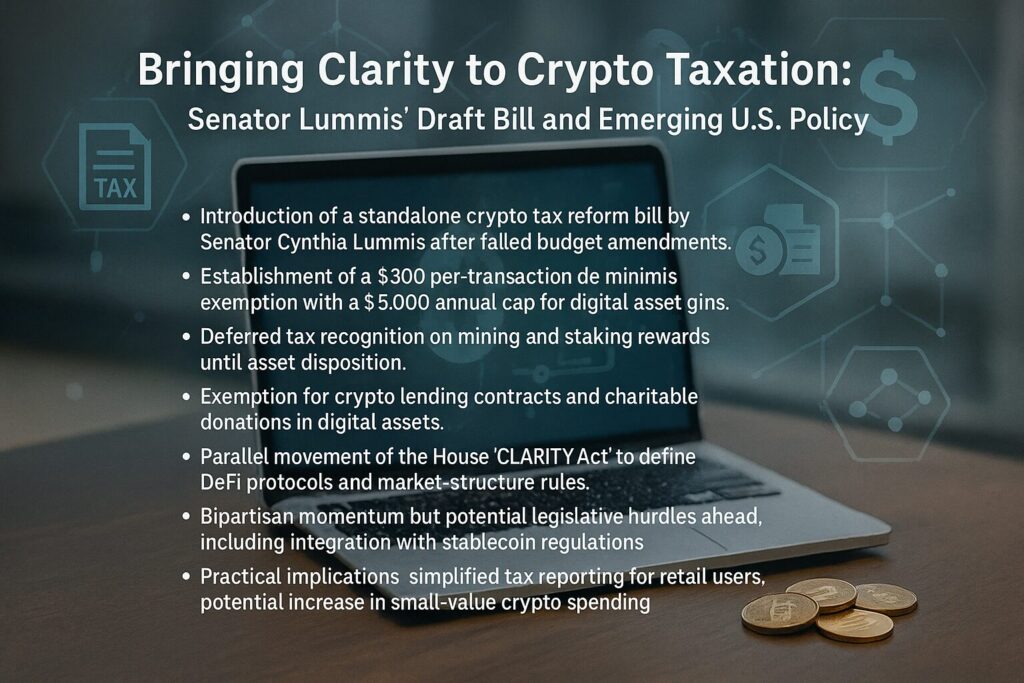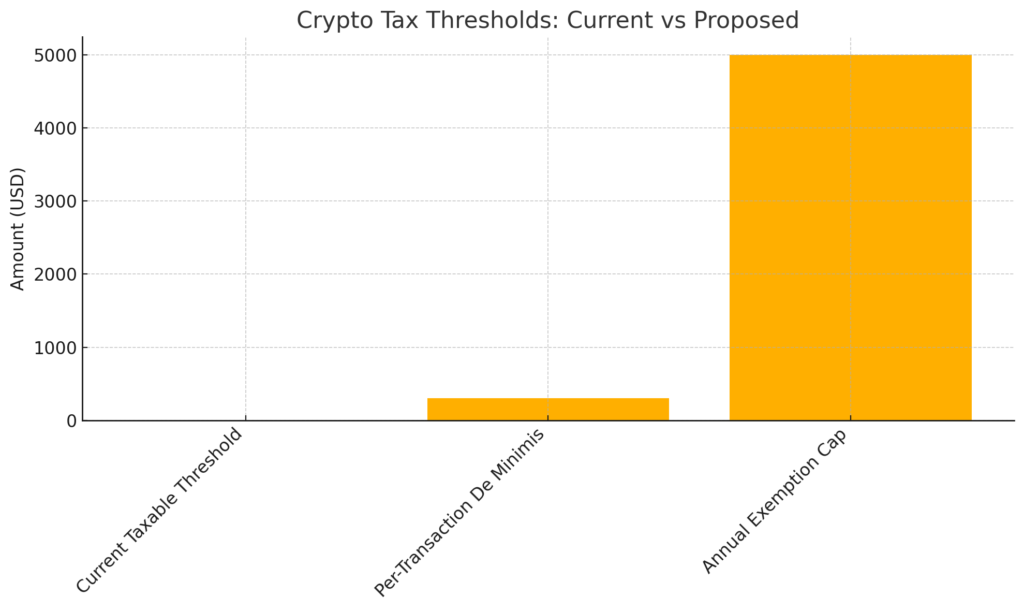
Main Points:
- Introduction of a standalone crypto tax reform bill by Senator Cynthia Lummis after failed budget amendments.
- Establishment of a $300 per-transaction de minimis exemption with a $5,000 annual cap for digital asset gains.
- Deferred tax recognition on mining and staking rewards until asset disposition.
- Exemption for crypto lending contracts and charitable donations in digital assets.
- Parallel movement of the House “CLARITY Act” to define DeFi protocols and market-structure rules.
- Bipartisan momentum but potential legislative hurdles ahead, including integration with stablecoin regulations.
- Practical implications: simplified tax reporting for retail users, potential increase in small-value crypto spending.
Background: U.S. Crypto Taxation Challenges
U.S. taxpayers currently face a complex and often punitive system when reporting gains or losses on digital asset transactions. Under present IRS guidance, every crypto-to-crypto swap or purchase triggers a taxable event, regardless of size. This has led to double-counting issues, voluminous record-keeping burdens for small transactions, and widespread frustration among investors and developers. The inability of current law to distinguish between a $5 crypto coffee purchase and a $5,000 trade has created a pernicious disincentive for everyday crypto use and innovation.
In response, Senator Cynthia Lummis (R-WY) put forward a draft bill on July 3, 2025, aiming to streamline the tax code for digital assets and eliminate bureaucratic hurdles that “blockchain functionality” in real-world use cases. Concurrent efforts in the House, notably the Digital Asset Market CLARITY Act, seek to establish a comprehensive regulatory framework for custodial and noncustodial platforms alike.
Key Provisions of the Lummis Draft Bill
1. De Minimis Exemption
The bill proposes a per-transaction de minimis exemption: any digital asset transaction or realized gain of $300 or less would be non-taxable, with a cumulative annual exemption cap of $5,000. This would effectively spare retail users from tracking every small coffee purchase or micro-investment, aligning U.S. policy with practices in other jurisdictions that recognize token fungibility for small-value transfers.
2. Deferred Tax on Mining and Staking
Under current rules, mining or staking rewards are taxed at “fair market value” upon receipt. The draft bill defers taxation on these rewards until the point of disposition—when the asset is sold or exchanged. This change could ease liquidity strains for small miners and validators who must currently sell a portion of their holdings immediately to cover tax obligations.
3. Exemptions for Lending and Charitable Giving
Crypto lending contracts—a key DeFi service—and charitable donations made in digital assets would be explicitly exempt from taxable events. By carving out these specific use cases, the bill encourages decentralized finance activity and philanthropic giving without fear of immediate tax liabilities.
Chart: Current vs. Proposed Tax Thresholds

Below is a visual comparison of the existing taxable event threshold (effectively $0 for every crypto transaction) versus the proposed $300 de minimis exemption and $5,000 annual cap.
(See chart above)
Stakeholder Reactions and Industry Implications
Industry voices have largely welcomed the Lummis draft as a “commonsense” approach that recognizes the unique characteristics of digital assets. DeFi protocol developers, often uncertain whether they fall under “transmitter” regulations, could see clarity with these exemptions, making protocols more accessible to average users. Retail investors may embrace crypto payments for everyday goods, now freed from potential IRS notices over tiny capital gains.
However, some tax policy experts caution that the $300 threshold may be too low to fully address recordkeeping burdens, suggesting a per-transaction exemption closer to $1,000. There are also concerns about the annual cap: sophisticated investors might fragment transactions across family members or wallets to exploit the $5,000 shield. Lawmakers will need to balance these gaming risks against the benefits of simplified compliance.
Legislative Landscape: CLARITY Act and Stablecoin Bill
Parallel to Lummis’ efforts, the House Digital Asset Market CLARITY Act is advancing, having cleared both the Financial Services and Agriculture Committees with bipartisan votes. The CLARITY Act aims to classify developers of fully decentralized protocols as non-transmitters, shield them from certain reporting duties, and set a market structure framework for custodial and noncustodial services.
Meanwhile, the Senate passed the bipartisan GENIUS Act to regulate stablecoins, establishing reserve and oversight requirements, which may merge with broader crypto legislation this summer. The week of July 14 was even branded “Crypto Week” by House leadership to accelerate action on these bills. The key question now is whether these pieces will coalesce into a single legislative package in the final spending bill or stall amid partisan negotiations.
Practical Takeaways for Crypto Investors
- Simplified Reporting: Once enacted, retail users making small purchases or swaps below $300 will no longer need to track cost basis for IRS reporting, significantly reducing accounting costs.
- Delayed Tax Cash Flow: Miners and stakers can hold their newly minted tokens without immediate tax liability, improving cash flow and supporting network security participation.
- Enhanced DeFi Access: Clear exempt status for lending and charitable donations can spur growth in peer-to-peer lending platforms and nonprofit fundraising using crypto.
- Strategic Planning: Investors approaching the $5,000 annual cap should monitor family or entity-level exposures to avoid accidental tax obligations; some may consider spreading activity across tax years or wallets.
Conclusion
Senator Lummis’ draft bill represents a significant shift toward recognizing practical use of digital assets and alleviating burdensome taxation for small transactions. By introducing a $300 per-transaction exemption and $5,000 annual cap, deferring tax on mining and staking, and exempting lending and charitable giving, the proposal seeks to harmonize tax law with real-world blockchain applications. Coupled with the House CLARITY Act and stablecoin regulations, Congress is poised to deliver a more coherent and growth-oriented digital asset framework. For investors and developers alike, these reforms could mark the turning point where crypto moves from niche speculative asset to everyday financial utility—provided Washington can translate draft bills into final law in the coming weeks.

